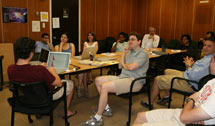
Handy Links
SLAC News Center
SLAC Today
- Subscribe
- Archives: Feb 2006-May 20, 2011
- Archives: May 23, 2011 and later
- Submit Feedback or Story Ideas
- About SLAC Today
SLAC News
Lab News
- Interactions
- Lightsources.org
- ILC NewsLine
- Int'l Science Grid This Week
- Fermilab Today
- Berkeley Lab News
- @brookhaven TODAY
- DOE Pulse
- CERN Courier
- DESY inForm
- US / LHC
SLAC Links
- Emergency
- Safety
- Policy Repository
- Site Entry Form

- Site Maps
- M & O Review
- Computing Status & Calendar
- SLAC Colloquium
- SLACspeak
- SLACspace
- SLAC Logo
- Café Menu
- Flea Market
- Web E-mail
- Marguerite Shuttle
- Discount Commuter Passes
-
Award Reporting Form
- SPIRES
- SciDoc
- Activity Groups
- Library
Stanford
Around the Bay
SLAC at the LHC: the Theory Behind It All
The ability to extract new physics from the Large Hadron Collider relies heavily on theoretical work. There are tantalizing hints that the LHC will produce new elementary particles. To identify these particles, researchers will need to know in detail how the Standard Model behaves at the high energies that the LHC will make available.
"The LHC data may confirm theories of supersymmetry, extra dimensions, or other models of new physics," said theory department head Michael Peskin. "Here in the SLAC theory group, this is the stuff we love—and the stuff we've been working on for 20 years or more."
The theory group is currently focusing its efforts on four topics that will be important in understanding the LHC data: precision Quantum Chromodynamics, or QCD, the construction of models of new physics beyond the Standard Model, tests of these models in proton collisions, and the simulation of proton-proton collision events.
QCD—the theory of the strong forces that bind quarks and gluons to make larger particles—requires extremely detailed and complex calculations to make precise predictions. SLAC theorists Lance Dixon, Darren Forde and Daniel Maitre, working with collaborators at other institutions, have written a computer program called BlackHat to carry out these calculations with the precision necessary to test the theory with the LHC. This program automates the computations, some of which involve millions of Feynman diagrams. The goal is to provide predictions, not just for simple quark-quark scattering, but also more-complex events involving W and Z bosons and many hadronic jets that will be seen at the LHC.
SLAC theorists Johan Alwall and Tanju Gleisberg are developing methods for modeling these complex events. It will be important to understand what kinds of event structures are produced by the current predications of QCD alone, and which can only occur if the LHC produces new particles.
The number and variety of possible models for new physics pose another problem: How can physicists search systematically for all of the possible signatures of these many different models? One of the best-studied of these models is that of supersymmetry. But even this one model can predict a wide variety of behaviors for different possibilities of the new particle masses. SLAC theorists Jacob Wacker, Johan Alwall, Mariangela Lisanti and My Phuong Le are now studying this problem using data from the Fermilab Tevatron. (See "Searching for Gluinos at the Tevatron.") They are analyzing the wide variety of signals that supersymmetry could produce and designing searches sensitive to the range of possibilities. "This is like a dress rehearsal of what you would do if you started seeing anomalies at the LHC," said Peskin.
SLAC and Stanford theorists Philip Schuster and Natalia Toro have another approach to this problem. They are developing a method for studying anomalies in data without having to view the data from the perspective of a predetermined theory. Their method generates increasingly refined conclusions to home in on the correct model.
As the LHC turns on, there is great interest in exotic phenomena that might be visible in the early data. SLAC theorist Tom Rizzo is studying a variety of such potential signals. One of these is the possibility of sharp resonances in the TeV energy region, perhaps from new Z bosons, perhaps due to new space dimensions. Rizzo and theorist JoAnne Hewett have been the experts in this subject since the 1980's. Rizzo is also studying the signals of possible black hole production at the LHC. In addition, SLAC theorist Masahiro Ibe has constructed supersymmetry models in which every new physics event contains two heavy particles that are stable on the short time scales of the LHC collisions. He has used this as a springboard to learn how to analyze the properties of such stable particles, which might be easy to spot in the experiments' muon detectors.
"We in the SLAC theory group have the attitude that we would like to be a resource, providing expertise for people on the West Coast, for the traditional SLAC users, and for the global community," said Peskin. "The LHC is going to be incredibly exciting, and we are looking forward to taking part in this effort."
Stay tuned! As the days leading up to the LHC turn-on dwindle, SLAC Today will continue its reports on SLAC's role. See the previous reports on SLAC computing and data and the ATLAS pixel detector and trigger system.
—Kelen Tuttle
SLAC Today, September 8, 2008
